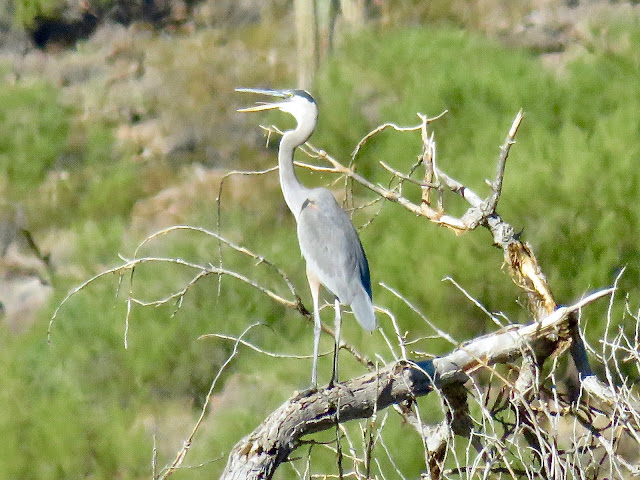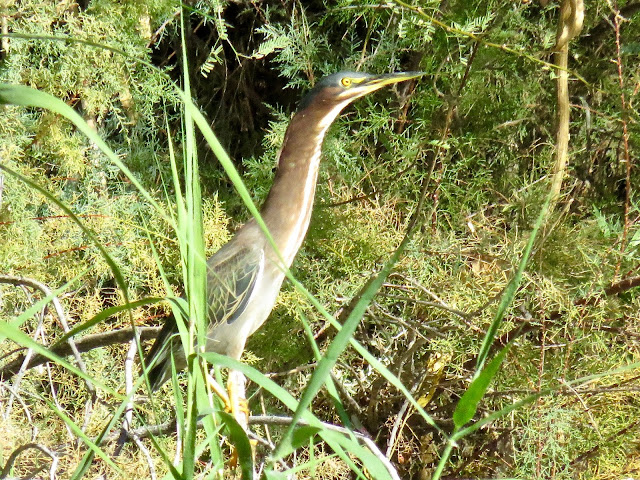About twice a year I visit this particular rec area along the Salt River. It's a good birding spot but in our "high season" when snowbirds visit, its large parking lots fill with motorhomes that rotate in and out on the required time frame for Tonto National Forest. Too many people; too much noise.
A ROCK WREN, foraging in the parking lot this morning, will be stunned by the influx of campers when they arrive. Usually found in canyons or mountain foothills, the bird seemed totally out of its habitat. Then, again, I'm happy it's flexible in that regard as habitat is changing everywhere.
 |
| ROCK WREN |
 |
| Juvenile GREAT BLUE HERON |
Check out the differences between this one and the juvenile in the photo above.
 |
| Adult GREAT BLUE HERON |
A familiar bird call was that of a BLACK PHOEBE that would later give a good photo opportunity.
 |
| BLACK PHOEBE |
The BELTED KINGFISHER is more difficult to find on its perch. We heard it more often than we saw it, but when we did catch a look, we confirmed that it carried the second band across its chest, a rufous one, indicating it was a female. Making many more trips east and west along the river than we did, the kingfisher was obviously in hunting mode.
From the thick reeds came the whinny of a Sora. When I hear that, I can't help grinning from ear to ear. It doesn't happen often, but when it does, birding is usually good.
In a small ponded area, we spotted about a dozen AMERICAN COOT, two AMERICAN WIGEON, and several COMMON GALLINULE.
Still walking eastward above the reeds, we heard KILLDEER and at least one GREATER YELLOWLEGS as it flew in announcing itself with its "tew, tew, tew" call.
In its basic (winter) plumage, the SPOTTED SANDPIPER has become familiar to us without its breeding spots that are reflected in its name. It's a medium-sized sandpiper that finds it hard to stand still even when its feet are planted. It dips forward and back, teetering from the rear end of its body.
 |
| SPOTTED SANDPIPER |
 |
| Yes, Snipe are real! TWO WILSON'S SNIPE |
Even at 10" in size, this is a fairly secretive bird and unless it comes out in the open like shown above, can be very hard to find in grassy wetlands with lots of hiding places. What was so very exciting was not that we found two such good birds; we saw another...and another...until we totaled nine (9) WILSON'S SNIPE. Never saw that many in one place before!
 |
| How many Wilson's Snipe can you find in the photo above? |
 |
| Two WILSON'S SNIPE with KILLDEER at right rear balanced on one leg |
 |
| Wilson's Snipe demonstrating how it uses that long bill to forage for snails, etc. |
 |
| Two more WILSON'S SNIPE |
Four species of woodpeckers were discovered as we walked the high trail from east to west (GILA, LADDER-BACKED, GILDED and RED-SHAFTED NORTHERN FLICKER).
Standing high in the parking lot on our way to the west side of the river, we enjoyed a mature BALD EAGLE fly over us.
But it was this final bird that had us guessing as to its identity. It was a bird we knew well as an adult, not in its juvenile plumage. In the distance (all the way across the river and east from us), it was extending its brown-striped neck way out beyond some reeds. Birders might imagine our adrenalin as we did our birder "wishful thinking"! But, no, saved (or foiled) by our photos; it was not a bittern; it was a juvie GREEN HERON.
 |
| Juvenile GREEN HERON - set of four photos |
Jeanne needed to leave a bit early, but Lindsay and I didn't stay much longer, finishing up at 10:40 a.m after a 7 a.m. start. We enjoyed our day together!
Spotting wildlife is always a plus. Today, it was wild horses and a racoon swimming out from and along the reeds.
It was an especially good day for me by having two juvenile herons present - ones I seldom see. Cooler temps, a very light breeze, running water where the Verde River flows into the Salt as well as some back area calm water presented a nice variety.
* * *
View this checklist online at http://ebird.org/ebird/view/checklist/S40380134








No comments:
Post a Comment